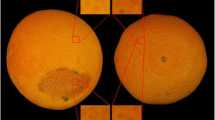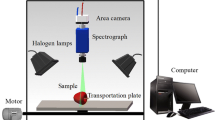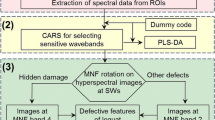Abstract
Automatic detection of fruit skin defects is always one of the main tasks of post-harvest processing of citrus fruit. However, it is a challenge to identify different types of defects simultaneously due to a high rate of unpredictability in texture and color of defects. In addition, as a typical spherical fruit, the uneven lighting distribution on the citrus is also one of the main problems causing low accuracy of defect detection. This study observed that the feasibility of using visible-near-infrared (Vis-NIR) hyperspectral reflectance imaging technology to identify the common seven types of skin defects on oranges and also classify the early decayed oranges from other samples simultaneously. Segmented principal component analysis (PCA), such as Vis-NIR-PCA, Vis-PCA and NIR-PCA, was first performed to reduce data dimensions and obtain the optimal principal component (PC) that was used to extract several characteristic wavelength images. Five characteristic wavelength images centered at around 540, 623, 675, 805, and 975 nm were selected based on the optimal Vis-NIR-PC2 image and weight coefficient analysis. The mean normalization method was used to correct the uneven lighting distribution on spherical orange fruit based on characteristic wavelength images. The multispectral image processing algorithms for detection of all defective oranges and classification of early decayed oranges are developed, respectively. For the investigated 397 independent test samples, an overall classification accuracy of 97.73% was obtained for differentiating normal and defective oranges based on mean-PC images combined with the improved watershed segmentation algorithm, and identification rate of 100% was obtained for classifying decayed and non-decayed oranges based on mean-PC5 and a simple global threshold. The results of this study can be used as a reference to develop the fast and low-cost multispectral image detection system for the rapid detection of defective citrus fruit and classification of specific oranges with early decay synchronously.















Similar content being viewed by others
References
Aboonajmi M, Najafabadi TA (2014) Prediction of poultry egg freshness Using Vis-Nir spectroscopy with maximum likelihood method. Int J Food Prop 17(10):2166–2176
Aboonajmi M, Saberi A, Najafabadi TA, Kondo N (2016) Quality assessment of poultry egg based on visible-near infrared spectroscopy and radial basis function networks. Int J Food Prop 19:1163–1172
Blasco J, Aleixos N, Gómez J, Moltó E (2007) Citrus sorting by identification of the most common defects using multispectral computer vision. J Food Eng 83:384–393
Blasco J, Aleixos N, Gomez-Sanchis J, Molto E (2009) Recognition and classification of external skin damage in citrus fruits using multispectral data and morphological features. Biosyst Eng 103(2):137–145
Cho BK, Kim MS, Baek IS, Kim DY, Lee WH, Kim J, Bae H, Kim YS (2013) Detection of cuticle defects on cherry tomatoes using hyperspectral fluorescence imagery. Postharvest Biol Technol 76:40–49
Cubero S, Lee WS, Aleixos N, Albert F, Blasco J (2016) Automated systems based on machine vision for inspecting citrus fruits from the field to postharvest-a review. Food Bioprocess Technol 9(10):1623–1639
Gomez-Sanchis J, Molto E, Camps-Valls G, Gomez-Chova L, Aleixos N, Blasco J (2008a) Automatic correction of the effects of the light source on spherical objects. An application to the analysis of hyperspectral images of citrus fruits. J Food Eng 85(2):91–200
Gomez-Sanchis J, Gomez-Chova L, Aleixos N, Camps-Valls G, Montesinos-Herrero C, Molto E, Blasco J (2008b) Hyperspectral system for early detection of rottenness caused by Penicillium digitatum in mandarins. J Food Eng 89:80–86
Gonzalez RC, Woods RE (2008) Digital Image Processing, Second edn. Publishing House of Electronics Industry, Beijing
Gowen AA, O"Donnell CP, Cullen PJ, Downey G, Frias JM (2007) Hyperspectral imaging-an emerging process analytical tool for food quality and safety control. Trends Food Sci Technol 18(12):590–598
Gowen AA, O’Donnell CP, Taghizadeh M, Cullen PJ, Frias JM, Downey G (2008) Hyperspectral imaging combined with principal component analysis for bruise damage detection on white mushrooms (Agaricus bisporus). J Chemom 22(3-4):259–267
Kim DG, Burks TF, Qin J, Bulanon DM (2009) Classification of grapefruit peel diseases using color texture feature analysis. Int J Agr Biol Eng 2(3):41–50
Li JB, Rao XQ, Ying YB (2011) Detection of common defects on oranges using hyperspectral reflectance imaging. Comput Electron Agric 78:38–48
Li JB, Rao XQ, Wang FJ, Wu W, Ying YB (2013) Automatic detection of common surface defects on oranges using combined lighting transform and image ratio methods. Postharvest Biol Technol 82:59–69
Li JB, Huang WQ, Zhao CJ (2015) Machine vision technology for detecting the external defects of fruit-a review. imaging Sci J 63(5):241–251
Li JB, Huang WQ, Tian X, Wang CP, Fan SX (2016) Zhao , C.J. Fast detection and visualization of early decay in citrus using Vis-NIR hyperspectral imaging. Comput Electron Agric 127:582–592
Li JB, Chen LP, Huang WQ (2018) Detection of early bruises on peaches (Amygdalus persica L.) using hyperspectral imaging coupled with improved watershed segmentation algorithm. Postharvest Biol Technol 135:104–113
Li JB, Zhang RY, Li JB, Wang ZL, Zhang HL, Zhan BS, Jiang YL (2019a) Detection of early decayed oranges based on multispectral principal component image combining both bi-dimensional empirical mode decomposition and watershed segmentation method. Postharvest Biol Technol 158:110986
Li JB, Luo W, Wang ZL, Fan SX (2019b) Early detection of decay on apples using hyperspectral reflectance imaging combining both principal component analysis and improved watershed segmentation method. Postharvest Biol Technol 149:235–246
Lopez-Garcia F, Andreu-Garcia G, Blasco J, Aleixos N, Valiente JM (2010) Automatic detection of skin defects in citrus fruits using a multivariate image analysis approach. Comput Electron Agric 71:189–197
Lorente D, Zude M, Regen C, Palou L, Gomez-Sanchis J, Blasco J (2013) Early decay detection in citrus fruit using laser-lightbackscattering imaging. Postharvest Biol Technol 86:424–430
Lu YZ, Huang YP, Lu RF (2017) Innovative hyperspectral imaging-based techniques for quality evaluation of fruits and vegetables a review. Appl Sci-Basel 7(2):189
Lu RF, Van Beers R, Saeys W, Li CY, Cen HY (2020) Measurement of optical properties of fruits and vegetables: A review. Postharvest Biol Technol 159:111003
Luo W, Zhang HL, Liu XM (2019) Hyperspectral/Multispectral Reflectance Imaging Combining with Watershed Segmentation Algorithm for Detection of Early Bruises on Apples with Different Peel Colors. Food Anal Methods 12(5):1218–1228
Momin MA, Kondo N, Ogawa Y, Ido K, Ninomiya K (2013a) Patterns of fluorescence associated with citrus peel defects. Eng Agr Environ Food 6(2):54–60
Momin MA, Kuramoto M, Kondo N, Ido K, Ogawa Y, Shiigi T, Ahmad U (2013b) Identification of UV-fluorescence components for detecting peel defects of lemon and Yuzu using machine vision. Eng Agr Environ Food 6(4):165–171
Niphadkar NP, Burks TF, Qin JW, Ritenour MA (2013) Estimation of citrus canker lesion size using hyperspectral reflectance imaging. Int J Agr Biol Eng 6(3):41–51
Obenland D, Margosan D, Collin S, Sievert J, Fjeld K, Arpaia M, Thompson J, Slaughter D (2009) Peel fluorescence as a means to identify freeze damaged navel oranges. HortTechnology 19(2):379–384
Obenland D, Margosan D, Smilanick JL (2010) Ultraviolet Fluorescence to Identify Navel Oranges with Poor Peel Quality and Decay. HortTechnology 20(6):991–995
Pan LQ, Zhang Q, Zhang W, Sun Y, Hu PC, Tu K (2016) Detection of cold injury in peaches by hyperspectral reflectance imaging and artificial neural network. Food Chem 192:134–141
Pathmanaban P, Gnanavel BK, Anandan SS (2019) Recent Application of imaging techniques for Fruit quality Assessment. Trends Food Sci Technol 94:32–42
Qin J, Lu R (2005) Detection of pits in tart cherries by hyperspectral transmission imaging. Trans ASAE 48(5):1963–1970
Rong D, Ying YB, Rao XQ (2017) Embedded vision detection of defective orange by fast adaptive lightness correction algorithm. Comput Electron Agric 138:48–59
Slaughter DC, Obenland DM, Thompson JF, Arpaia ML, Margosan DA (2008) Non-destructive freeze damage detection in oranges using machine vision and ultraviolet fluorescence. Postharvest Biol Technol 48:341–346
Tao Y, Wen Z (1999) An adaptive spherical image transform for high speed fruit defect detection. Trans ASAE 42(1):241–246
Torres I, Sancheza MT, Cho BK, Garrido-Varo A, Perez-Marin D (2019) Setting up a methodology to distinguish between green oranges and leaves using hyperspectral imaging. Comput Electron Agric 167:105070
Vargas AM, Kim MS, Tao Y, Lefcourt AM, Chen YR, Luo Y, Song Y, Buchanan R (2005) Defection of fecal contamination on cantaloupes using hyperspectral fluorescence imagery. J Food Sci 70:471–476
Wei X, He JC, Ye DP, Jie DF (2017) Navel orange maturity classification by multispectral indexes based on hyperspectral diffuse transmittance imaging. J Food Qual 2017:1023498. https://doi.org/10.1155/2017/1023498
Zhang BH, Huang WQ, Li JB, Zhao CJ, Wu JT, Fan SX (2014) Principles, developments and applications of computer vision for external quality inspection of fruit and vegetables: a review. Food Res Int 62:326–343
Zhang C, Zhao CJ, Huang WQ, Wang QY, Liu SG, Li JB, Guo ZM (2017) Automatic detection of defective apples using NIR coded structured light and fast lightness correction. J Food Eng 203:69–82
Zhang H, Zhang S, Dong W, Luo W, Huang Y, Zhan B, Liu X (2020a) Detection of common defects on mandarins by using visible and near infrared hyperspectral imaging. Infrared Phys Technol 108:103341
Zhang H, Zhan B, Pan F, Luo W (2020b) Determination of soluble solids content in oranges using visible and near infrared full transmittance hyperspectral imaging with comparative analysis of models. Postharvest Biol Technol 163:111148
Zhu XL, Li GH (2019) Rapid detection and visualization of slight bruise on apples using hyperspectral imaging. Int J Food Prop 22(1):1709–1719
Acknowledgments
This study was supported by National Natural Science Foundation of China (41867020), Jiangxi Provincial Department of Science and Technology Project (20181BBF60024), Jiangxi Provincial Department of education project (GJJ200612 and GJJ200609), Key R & D projects in Jiangxi Province (20203BBF63031).
Author information
Authors and Affiliations
Corresponding authors
Ethics declarations
Conflict of Interest
Hailiang Zhang declares that there is no conflict of interest. Ying Chen declares that there is no conflict of interest. Xuemei Liu declares that there is no conflict of interest. Yifeng Huang declares that there is no conflict of interest. Baishao Zhan declares that there is no conflict of interest. Wei Luo declares that there is no conflict of interest.
Ethical Approval
This article has no any study with human participants or animals by any of the authors.
Informed Consent
Not applicable.
Additional information
Publisher’s Note
Springer Nature remains neutral with regard to jurisdictional claims in published maps and institutional affiliations.
Rights and permissions
About this article
Cite this article
Zhang, H., Chen, Y., Liu, X. et al. Identification of Common Skin Defects and Classification of Early Decayed Citrus Using Hyperspectral Imaging Technique. Food Anal. Methods 14, 1176–1193 (2021). https://doi.org/10.1007/s12161-020-01960-8
Received:
Accepted:
Published:
Issue Date:
DOI: https://doi.org/10.1007/s12161-020-01960-8




